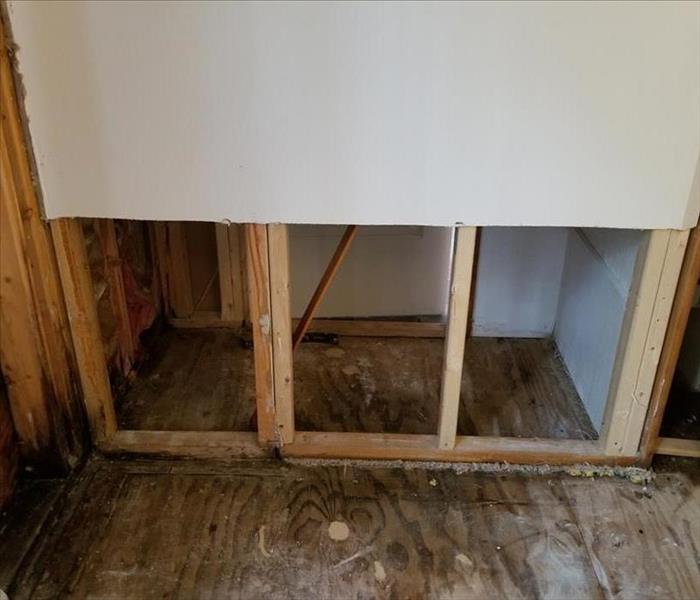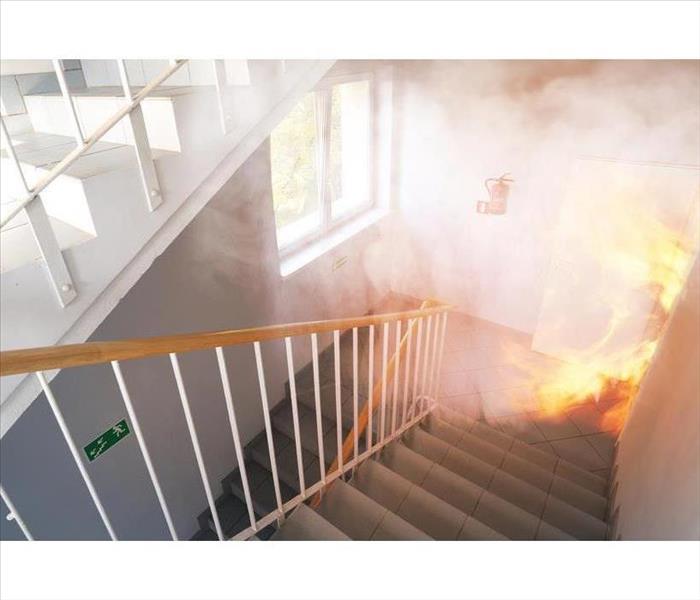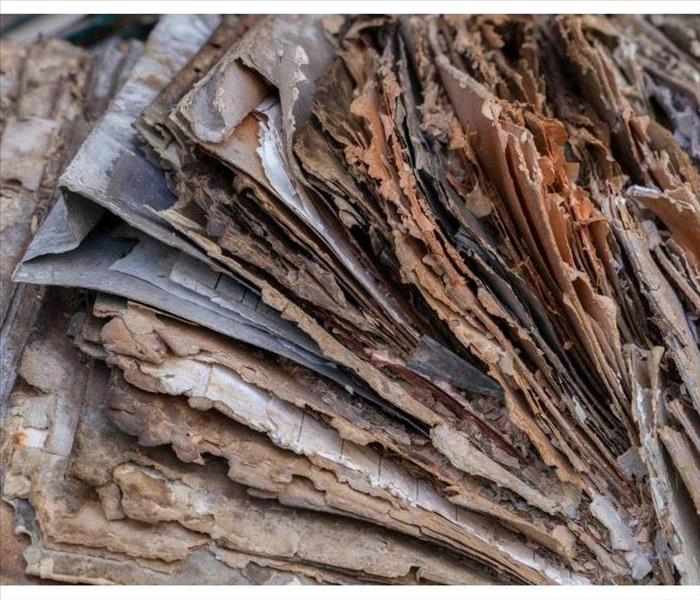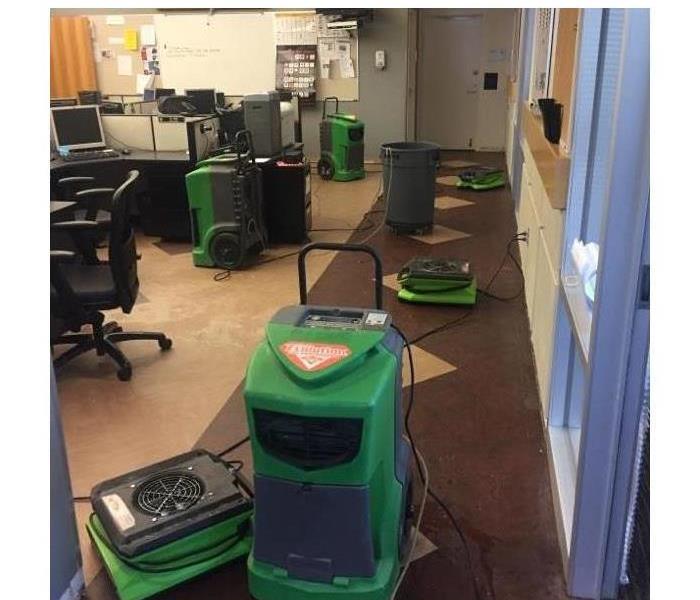Archived Commercial Blog Posts
Why You Need A Fire Escape Plan For Your Business
10/27/2022 (Permalink)
 We hope you never need to use your office fire escape plan, but it's always a good idea to be prepared in case of a disaster!
We hope you never need to use your office fire escape plan, but it's always a good idea to be prepared in case of a disaster!
Why Does Your Company Need a Fire Escape Plan?
It's important to know how to escape a burning building. As an employee, manager, or owner of a business, you can help make sure everyone knows what to do in the event of a fire. To create an office fire escape plan, follow these simple steps:
1. Contact your local fire department, a professional in fire safety, or the Red Cross for help creating a fire escape plan for your office.
If you don’t have a background in fire safety and don’t know where to turn for help, the best place to start is with your local fire department. They can help you create a plan that will keep everyone safe during an emergency. If you want to go the distance, consider hiring a professional in fire safety or contacting the Red Cross—both organizations offer resources for creating emergency plans tailored specifically to office buildings.
2. Plan multiple ways to get out of every room.
An effective exit plan is one that takes every possibility into account. It should account for multiple ways to get out of every room, as well as a variety of methods to exit the building itself. When creating an office fire escape plan, you can’t assume that everyone will make it out in time simply by following the main exit route. If employees have no idea how to get out of their particular room or area, they won’t be able to do so when time is running short and panic sets in—which means they may not make it at all!
To help ensure that everyone knows how to get out safely, write down a list of all possible routes from each room and post them somewhere visible for easy reference during an emergency situation. Include any alternate exits located near windows or other openings like balcony doors or air vents.
3. Decide on a safe meeting place outside of the office building.
Choosing a safe meeting place outside of your office will give you and your coworkers a meet up spot and help you all feel more secure. If a fire breaks out or there is some other crisis, this will help you make the most of your time following the evacuation procedure. A good meeting place should be:
- A safe distance from your office building
- Easily accessible by everyone.
- Not too crowded.
4. Designate someone to help any employee that may need extra assistance because of a disability or injury.
If you have employees with disabilities or injuries, you should designate several people to help any employee that may need extra assistance. These people should be able to help the employee get out of the building safely and be familiar with navigating around your office building.
5. Make sure all employees know how to call 911 and alert others when they need help.
The final step of an office fire escape plan is to make sure all your employees know how to call 911 and alert others when they need help. This can take the form of hitting a fire alarm or pushing an emergency alert button. It’s also important for employers to train their employees on what other people should do if they see someone struggling in a high-rise building, so that everyone will be prepared for any eventuality.
We hope that you never have to use your office fire escape plan, but it’s important to be prepared in case of a disaster!
Tips for a Mold-free Restaurant
8/24/2022 (Permalink)
 Use plastic wrap or containers to cover any food that is out for prep or serving.
Use plastic wrap or containers to cover any food that is out for prep or serving.
Mold Risk In a Restaurant
Mold spores are abundant in our environment, but problems develop when they get inside your building and find damp places to grow and reproduce. Sometimes you smell mold before you see it, as the release of mycotoxins from the digestive process is what makes that familiar musty smell. The constant cooking and washing in a restaurant increase the opportunity for mold growth, but you can take steps to reduce your risk through inspection, maintenance, and cleanliness. Really, there are two main categories to manage for mold risk in your restaurant: food and building.
Protect Food
Since mold spores are all around the environment, it's important to take additional precautions to protect food from mold growth. Here are a few things you can do to keep the food safe in your restaurant in Temple, TX.
1. Buy quality food and check it for signs of mold
2. Use plastic wrap to cover any food that is out for prep or serving
3. Refrigerate unused foods quickly into clean containers and cover tightly
4. Mold can grow in the refrigerator so use leftovers in 3-4 days before mold has a chance to grow
Maintain the Building
A restaurant presents additional moisture problems because of the kitchen environment. The kitchen space is packed tight with equipment and ventilation is often challenging resulting in high humidity. It's important to check frequently for problems and maintain equipment. Here are some places to pay attention to and to keep clean.
1. Use ventilation systems as well as heating and air conditioning systems to keep humidity levels under 40%
2. Maintain ventilation hoods and ductwork for cleanliness and proper function
3. Keep all rags and sponges clean and dry, if anything smells musty throw it out
4. Regularly clean the refrigerator, including rubber casings, with a baking soda solution (1 tablespoon per quart of water)
5. Check for leaks and water damage around the plumbing
When you do have mold growth, you can count on professional remediation specialists who clean up mold using special equipment and methods that contain the area and prevent the further spread of spores in your restaurant.
What You Will Need To Tear Out After a Flood
6/1/2022 (Permalink)
 Water damage on drywall is also obvious to your customers. It manifests itself as unsightly dark grey or brown spots.
Water damage on drywall is also obvious to your customers. It manifests itself as unsightly dark grey or brown spots.
What You'll Need To Remove After A Flood
Noone likes the daunting prospect of considering what to leave and what to tear out after their business floods. It might not be just what the insurance covers or what the contractor recommends. There are a few things that need to be replaced once they go through a storm or flood.
Drywall
Drywall is the first thing that you need to consider. It is a major source of mold and mildew once it has been soaked in water. This can cause:
- Health issues
- Strange smells
- Crumbling
- Black spots
Once it starts to grow inside your business, you will need a mold remediation company in Temple, TX, to help you clean it up.
Water damage on drywall is also very visible to your customers. It appears as unsightly dark grey or brown spots. These spots make your business interior look neglected.
Trim
Another area of concern is your trim. You may have to replace the trim around windows, doors or walls. Even if a small amount of water gets into your business, you should replace your baseboards at least.
This includes having to tear out crown molding or chair rails just in case the water has damaged them. When you replace it, you may want to consider a PVC or plastic molding instead, particularly if you live in an area where flooding is likely to occur.
Cabinets
Depending on what the cabinet is made out of, your cabinets may need to be replaced. If they are made from wood, the storm restoration company might be able to pull them out and reset them after the cabinets dry. If they are pressboard, then there is a good chance the water will warp them beyond recognition.
After a flood, check these areas to make sure that there is no damage. It is often better to tear out a wall, cabinet, or trim piece that might be waterlogged than allow the damaged portion to remain.
What Is Hidden Damage After a Fire?
5/13/2022 (Permalink)
 While dealing with a fire at work is stressful enough, other factors can also cause problems. Water and smoke damage can be caused by a fire.
While dealing with a fire at work is stressful enough, other factors can also cause problems. Water and smoke damage can be caused by a fire.
What Is Hidden Damage Following A Fire?
While experiencing a fire at your Temple, TX, business is hard enough, other factors can also cause you headaches. A fire can cause hidden damage such as water and smoke damage.
What Is Hidden Damage From a Fire?
The most obvious cause of damage from a fire is the flames. They can destroy part of all of your property. However, a fire that does not entirely devastate your business can cause what is known as partial damage. Areas of your building may be affected without the entire property succumbing to fire. Fire can leave hidden damage from:
- Water from fire hoses
- Soot damage on electronics and other items
- A smoke odor that lingers on porous surfaces
These types of damage may not be evident immediately after a fire. You may discover, for example, that your electronics are covered in a sticky, corrosive substance left behind by smoke. You may notice a lingering odor in your carpets or furniture that won't go away without the help of a professional restoration company.
What Can Be Done About Smoke Damage?
Fortunately, damage from smoke is a covered loss in most insurance policies. You can also receive compensation if the fire took place in a neighboring business but also caused damage to your property.
After a fire, it's a good idea to check with your insurance agent to find out what is covered and get started with the cleanup process right away.
A restoration company can help you with smoke cleaning. Technicians may use methods such as:
- Wet cleaning for moderate or heavy surface damage
- Dry cleaning for pre-treatment or light damage
- Abrasive cleaning on heavily covered surfaces
- Foam cleaning for delicate fabrics
- Immersion cleaning for coated surfaces that can be dipped in cleaner
Whether your property or one nearby suffered a fire, you can get help with hidden smoke damage and get back to business as soon as possible.
Why You Need Document Restoration Professionals After a Disaster
3/14/2022 (Permalink)
 When it comes to document restoration, time is of the essence. Water damage can occur in any size disaster, from a large flood to a small pipe leak.
When it comes to document restoration, time is of the essence. Water damage can occur in any size disaster, from a large flood to a small pipe leak.
Why Do You Need Document Restoration Experts After a Disaster?
When it comes to document restoration, time is of the essence. Water damage can occur in any size disaster, from a large flood to a small pipe leak. Your commercial business needs to know what to do in order to be prepared. This will lessen the chances of irreversible damage that can happen in as little as 48 hours.
Types of Documents That May Be Damaged
If you sit back and think of all the paper goods and documents in your commercial business, the list ends up long. Here are some examples of paper to itemize when preparing for document restoration:
- Paper contracts
- Books, magazines, etc.
- Manuscripts
- Photographs
- X-Rays
- Blueprints
- Mapz
- Marketing materials
- Artifacts
When dealing with historic artifacts, in particular, document drying methods should be approved by the National Archives and Records Administration and the General Services Administration. Luckily, SERVPRO methods are already approved, keeping the costs lower for commercial companies in Temple, TX.
Steps To Salvage Documents
There is no need to outsource document drying if the local storm response team brought in is well-versed in the process. This is important for not only artifacts, but all paper goods that may be damaged. Here are the steps that should be taken by professionals:
- HIPPA Master-certification
- 24/7 surveillance
- Vacuum freeze-drying
- Gamma irradiation sterilization
- Re-jacketing
- Deodorization
- Digitization
Why You Need Professionals
Attempting document restoration on your own can not only be time-consuming, but it can damage the integrity of the documents or even ruin them completely. It can also be harmful if the necessary precautions aren't taken. Depending on the level of water contamination, the documents may harbor hazardous chemicals, viruses, and bacteria. This can be caused by sewage leaks, floods, or stagnant water.
SERVPRO sterilizes the documents to ensure safety. Not to mention, the SERVPRO process makes your documents digital! This way, you won't have to worry about a future disaster impacting your access to important information.
What’s In Flood Water?
2/14/2022 (Permalink)
 If your business is damaged by any water damage, don't hesitate and give our SERVPRO team a call.
If your business is damaged by any water damage, don't hesitate and give our SERVPRO team a call.
What Do Flood Waters Contain?
Water damage is classified into three categories. Category One water is clean. Category Two water, or gray water, is contaminated, but does not contain solid waste. Category Three water, is severely contaminated. This water originates from a flood or sewer backup. Find out more about why it is necessary to disinfect any building materials and contents exposed to flooding.
Contaminants
Category Three water may contain a variety of contaminants. When flooding occurs, surface water may carry any of the following contents:
- Bacteria
- Chemicals
- Hazardous waste
- Heavy metals
- Sewage
When a body of surface water overflows or heavy rain accumulates, this water may mingle with overflow from sewer mains. Water accumulates more contaminants as it flows. For this reason, it is important to extract standing water before cleaning and disinfecting any parts of a commercial structure exposed to this type of water damage.
Protective Equipment
Building occupants should take measures to limit exposure to contaminated water. It may be helpful to keep the following personal protective items on site:
- Goggles or safety glasses
- Heavy work gloves
- Hip waders
- Watertight boots with electrical insulation
All of these pieces of equipment can be useful if a building occupant needs to move through flood water for any reason. Individuals should factor in the depth and speed of the water when deciding whether to cross.
Cleanup Procedures
There are several stages to cleaning up flooding. A commercial restoration company will extract category three water with a pump or other specialized equipment. It may be necessary to tear out damaged building materials. Afterwards, the area should be cleaned, disinfected and dried. Once the area is totally dry, restoration can proceed.
It is important to exercise caution during flooding in Temple, TX. The owner of a commercial building should contact mitigation and restoration professionals as soon as possible to start the water damage cleanup process.
 We hope you never need to use your office fire escape plan, but it's always a good idea to be prepared in case of a disaster!
We hope you never need to use your office fire escape plan, but it's always a good idea to be prepared in case of a disaster!



 24/7 Emergency Service
24/7 Emergency Service




